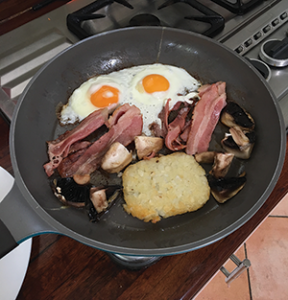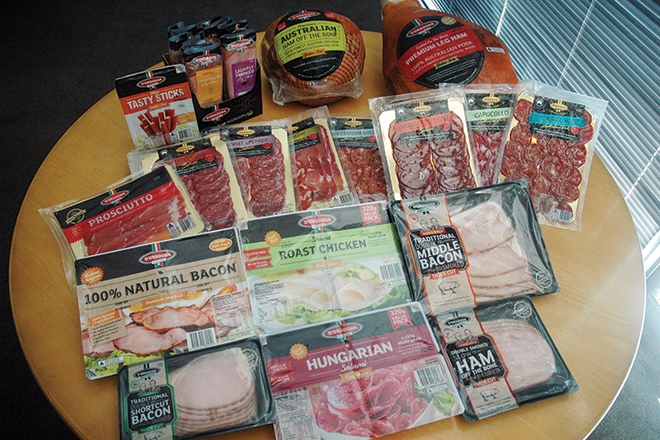
The author’s occasional indulgent weekend breakfast complements the working week’s sardines on sourdough toast, topped with turmeric and garden greens.
SPENDING a few weeks in Portugal and Italy over September and October meant I’d have missed the editorial deadline for October’s
APN, hence writing this pre-trip while contemplating the trip two days out from departure. One expectation I have is enjoying some quality pork and processed meats, especially in Italy, where I have done exactly that in years past. As for Portugal, where I’ve not been before, my understanding is it’ll be a bit more seafood driven while in Lisbon and Porto.
I can deal with that. After all, sardines on toast, topped with turmeric, some garden greens, olive oil and balsamic vinegar has long been my go-to daily breakfast. Of course, the Italians are famous for their charcuterie or traditional art of preparing and assembling cured meats and other meat products.
While we are well catered for down under with traditional Italian smallgoods from the likes of market leader D’Orsogna and some smaller artisan producers of continental delights, place of origin eating and dining always adds a sensory hit akin to watching Steve Smith carve out a century against struggling poms.
That is, it’s an experience like no other and one filled with pleasure and a lifetime of memories. Cured meats, which is really what we’re talking about, are the result of the oldest possible food preservation and flavouring techniques and they come in many forms and lots of varieties.
I confess, there are really none I don’t take a fancy to and I probably will indulge in most while in Italy. Here’s a few examples of my understanding of where my taste buds are likely to take me in Italy:
- Prosciutto, made from the whole hind leg of a pig (the ham) and comes salt-cured and air-dried. Typically, it’s enjoyed in very thin slices and has a slightly chewy texture.
- Italian salami is traditionally made from lightly ground beef or pork combined with seasoning and animal fat, which is then stuffed into a casing. The sausage is hung in a controlled room where the vital fermentation process begins. The more time salami spends fermenting, the drier it will be, meaning certain types of salami will be juicier and fattier than others.
- Pepperoni, I understand created by Italian Americans in the early 1900s, is made from a mixture of finely ground beef and pork, with seasonings added to create that savoury, slightly spicy flavour.
- Pancetta, the Italian version of bacon, is made by seasoning a pork belly side with salt and lots of pepper, curling it into a tight roll and then wrapping it in a casing to hold the shape. It’s cured, but not smoked.
- Coppa, or capicola, is made from the neck or shoulder of the pig, has a tender texture and is usually smoked and prepared with a variety of spices, herbs and sometimes wine.
- Cacciatore literally means hunter, and folklore states hunters carried this little salami in their packs and ate bits for sustenance during the hunt. Cacciatore is typically about 18cm long and is cured with the usual spices, wine and herbs. It tends to be a little chewier than coppa and prosciutto.
Interestingly and somewhat alarmingly in some circles, the names of some of these products are under threat in Australia, with the European Union currently negotiating a free-trade agreement with Australia. As part of this, geographical indications, a form of intellectual property protecting the names of specific products, is a key element of the negotiations.
The EU is asking Australia to extend the protection of these names from wines to spirits and foodstuffs. I know that here in the west, at an August meeting called by IP Australia, Department of Agriculture and Food, and Department of Foreign Affairs and Trade, industry participants were asked by DFAT to forward any objections to assist the Australian government in their negotiations concerning this issue.
I understand the letter was to be submitted to DFAT by September 13. The list of foodstuff names the EU wants Australia to protect as GIs is 172 long. Ouch! Listed processed meats that have long been household names down under include prosciutto, salami, mortadella and speck.
Popular cheeses such as pecorino, mozzarella and edam also made the list.The EU has requested EU GI names be protected against:
- Any direct or indirect commercial use of a GI name: (a) for comparable products; or (b) in so far as such use exploits the reputation of the GI, including when that product is used as an ingredient.
- Any misuse, imitation or evocation, even if the true origin of the product is indicated or if the protected name is translated, transcribed, transliterated or accompanied by an expression such as style, type, method, as produced in, imitation, flavour, like or similar, including when those products are used as an ingredient.
- Any other false or misleading indication as to the origin, nature or essential qualities of the product, on the inner or outer packaging, advertising material or documents relating to the product concerned, and the packing of the product in a container liable to convey a false impression as to its origin, including when those products are used as an ingredient.
- Any other practice liable to mislead the consumer as to the true origin of the product.
Australia and the EU launched negotiations for a FTA in June 2018. As a bloc, the EU is Australia’s second-largest trading partner, third-largest export destination and second-largest services export market. The EU was Australia’s largest source of foreign investment in 2018. While all of this won’t worry me while I chow down on some cacciatore in Italy, sipping on a nice glass of sangiovese or barbera, it will be a concern back home.
Ciao for now.
Brendon Cant







